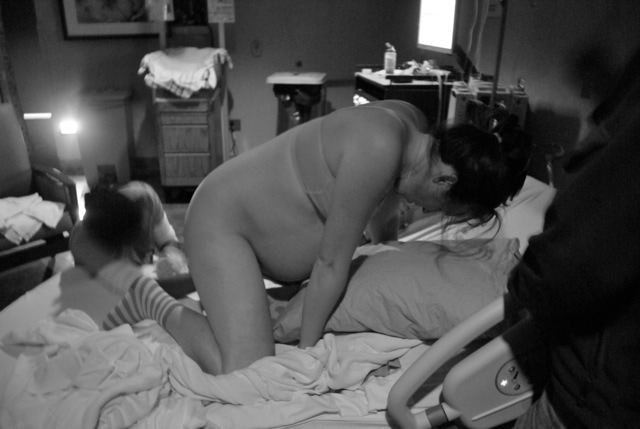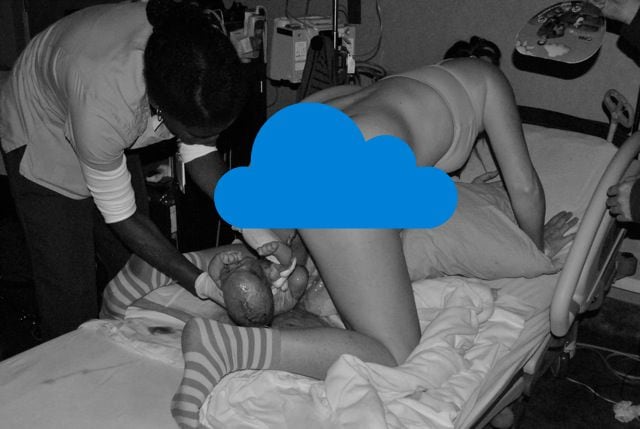I’ve seen a handful of articles floating around on the interwebs saying that during delivery, women don’t have to push. This is not helpful information!
Based on my experience in the classroom as a childbirth educator, and in the birth room as a doula, this blanket statement seems to have confused and given some parents unreasonable expectations regarding birth. As your friendly neighborhood childbirth educator, please stop telling women they don’t have to push.
Ultimately, telling moms they don’t have to push is a disservice to those preparing to give birth, especially for the first time. In this article I explain why we should stop telling women they don’t have to push, and what to do instead. Let’s get started!

Stop Telling Women They Don’t Have to Push!
Pushing and the birth of a baby encompass the second stage of labor, coming right after stage one (contractions and dilation), and before the third stage, delivery of the placenta.
Before we dive in, let’s describe the goals of the pushing stage of labor. I believe that the goals of pushing are…
1) a healthy baby to descend
2) in a reasonable amount of time
3) while minimizing any trauma to the baby and mother.
Fetal Ejection Reflex
Curious how the pushing stage actually works? It’s really interesting, actually. You see, the act of pushing is involuntary – something your body does without permission. Once the cervix is open completely (10 cm) and all that’s there is baby’s head, the body starts pushing all on its own. This is called the fetal ejection reflex.
You know how the body just sneezes or vomits whenever it deems necessary? That’s kinda how the fetal ejection reflex works. It’s nothing you can control, but just like a sneeze or throwing up, you can make it more or less powerful by giving into it and using your abdominal muscles. Or you could hold back and only throw up only part of your lunch or sneeze daintily. 😉
Breathing Baby Down
Many women say that actively pushing during the pushing stage is unnecessary because the fetal ejection reflex will do all the pushing work for them. Instead of pushing women are encouraged to “breath their baby down”, which means to continue breathing while the body does its thing during each pushing contraction.
I’m going to throw something out there that’s pretty controversial, but in my experience, not all women are able to “breathe their babies down” and just let the pushing reflex do its thing.
Yes, I’ve seen and personally experienced this phenomenon. But I’ve also seen and personally experienced the opposite. Sometimes women have to push, HARD, in many different positions, and for a long time for their babies to descend.

In the above photo I was pushing my first child out. I had to push with everything I had! I was a bit surprised at how much work it was. It took me 2.5 hours with my first.
With my second and third (see the three photos below), however, I pushed them out in a matter of minutes. It was shockingly different. They came so quickly!



Wide Range of Normal
Just like it’s important to understand the fetal ejection reflex, it’s also important to understand that birth falls on a spectrum and that there is a wide range of normal.
For example, some babies come so fast without any added effort from mom, and some women push for hours in “all the spinning babies positions” and have to work very, very hard. But most fall somewhere in between and are well within the range of normal.
Instead of saying pushing is or will be a certain way, perhaps it’s best to understand the many possibilities of pushing, without pigeon-hole’ing ourselves to only one, and remain open to whatever comes our way.
Pushing is Hard Work
Because women are told to not push during the pushing stage of labor, many expect pushing to be easy. Don’t get me wrong, many women actually enjoy pushing compared to the first stage of labor, because they feel like they can finally do something about their contractions instead of simply cope. However, women are sometimes surprised by the sensations of pushing because they expected pushing would be instinctual and easy.
It is instinctual, but by golly, especially for first time moms, it’s still a lot of work. It’s such hard work that many women get hot and sweaty! Quite a few find the sensation of a cold washcloth on their forehead and/or the back of their neck to be refreshing. They also need lots of cold water to stay hydrated – it’s a workout!

Thoughts on Hypnobirthing
Many women who believe in the idea that pushing isn’t necessary during the second stage of labor also subscribe to the HypnoBirthing method of childbirth preparation.
In my opinion, one of the problems with HypnoBirthing is that they teach to not push during the second stage of labor because the body will do it all by itself. Again, the problem is not so much that this is a false statement, but that it’s teaching only one way of giving birth. Let me explain.
When a woman is fully dilated, she typically feels a strong, reflexive urge to push. This urge is involuntary, and something that the body just does. The fetal ejection reflex is a powerful, whole body sensation that guides women through the second stage of labor. For parents that have never given birth, I often compare it to the vomiting reflex – it happens all by itself.
On one hand, I understand where HypnoBirthing is coming from. In many cases, when it comes to pushing, especially with women that have already given birth, there isn’t anything extra to be done. All that’s required is to be completely in the moment as contractions literally eject the baby out of the body.

But this isn’t the case for every woman, especially for those that have not had a previous vaginal delivery. Many women need to put forth great strength behind each pushing contraction to birth their babies. Some have to give everything they’ve got – for hours! This may not be the average woman’s experience, but it’s well within the range of normal.
For HypnoBirthing parents, it can be a challenge to switch gears if a different type of pushing is required. It’s a bit of a learning curve to switch from not pushing to big, strong, gorilla-like pushes. However, once a woman realizes what’s working, there’s progress to be seen!
What to Do Instead: Follow Your Instincts
Ladies, your body was designed to give birth and knows just what to do. Some of you will push with minimal extra effort, some will push for hours giving it all you’ve got, and most of you will fall somewhere in the middle. Pushing is instinctual and it’s something that you can play around with to see what works best.
Coached Pushing
Coached or forced pushing is when a nurse or other birth attendant instructs a woman to hold her breath and push while counting to ten, two to three times through, during each contraction. It may also look like a doctor or midwife telling a woman to push after baby’s head is out, but between contractions, when she has no urge to push.
Coached pushing is not very instinctual, and can lead to pelvic floor disfunction and/or tearing.
If a woman is pushing in a way that is forceful and unnatural, odds are she is experiencing coached pushing instead of spontaneous, undirected pushing. For a woman that is unmedicated, it’s best for care providers to be hands off .
I will say, however, that feedback during pushing can be helpful, especially for those with an epidural. An epidural numbs the body, making it difficult for a woman to follow her instincts. However, I think that when women are left to figure out pushing on their own, they do amazingly well – they’re just not typically given the chance!
Push with Great Strength, Slowly and Gently
Instead of coached pushing, it’s best to push instinctively with great strength, but slowly and gently. Before baby is crowning, it may be helpful to envision pushing with the strength of a gorilla. However, when baby is crowning, pushing slowly and gently is a great way to prevent tearing.
Listen to your body and care provider as they guide you through these intense moments of birth. Anything you can do to allow things to unfold slowly will help keep your lady bits intact. Some women find doing “horse lips” or pretending like they’re blowing out a candle are helpful to push slowly. Other women find it helpful to apply counter pressure on their own perineum and baby’s head while baby is crowning.
What to Do Instead: Hire a Rock Star Birth Team
Having a rock star birth team can encourage you to follow your instincts, and provide encouragement and guidance throughout pregnancy and childbirth.
Find a Solid Care Provider
One of the most influential people in the life of an expecting mother is her care provider. A doctor or midwife has the capability to influence her birth outcomes and satisfaction with her experiences. Since the OBGYN or midwife a woman chooses so profoundly impacts her pregnancy, birth, and postpartum experience, it makes sense to choose this person wisely.
Surprisingly, sometimes the gynecologist we had in college doesn’t cut it for pregnancy care. It may be time to fire your OB (or midwife!) and move on.
Choose a care provider that makes an effort to get to know you during prenatal visits, listens, uses evidence based practices, etc. Steer clear of care providers that make your internal warning bells go off! Your baby only gets one birth. You only get one first birth. You are so, so worth it!

Stop Telling Women They Don’t Have to Push!
Friends, let us be mindful about how we speak to our sisters about birth. Instead of telling women they don’t have to push, let’s explain all the possibilities. When women better understand the spectrum of childbirth, they’ll be more confident to follow their instincts, no matter what happens.

Allison
Monday 22nd of January 2024
This is a great article. I write a blog about pregnancy and birth and I STILL struggled with this popular teaching. Just hearing you say that it's totally normal for some women - or even one woman at different times - to need to push for hours vs breathing the baby down, helped me feel a lot less anxious about it. I pushed for 3 hours with my first (at home) and since reading about HypnoBirthing (which has some good things to teach, I don't deny), I wondered if those 3 hours were necessary effort or if I could have done something better. Maybe. But probably not. Anyways. Thank you!
Lindsey VanAlstyne
Monday 22nd of January 2024
You're welcome! Glad you found it helpful. I wish more women could understand this. :)
Dana
Sunday 30th of July 2023
If the settings are right and the Mother feels unobserved and relaxed and is unmedicated there is a high chance she will experience a fetal ejection reflex. The issue is the drugs, the bright lights, feeling observed etc. There was a study that showed it is highly unlikely to experience a fetal ejection reflex in a hospital because its not a relaxed environment. But I feel if we talk to women, show them the studies, books, birthing videos so that they can understand there isn't always the need to push hard or be directed like in movies or on one born every minute. It is an amazing experience and it has a lot of benefits for example not tearing, damaging the pelvic floor, or bursting blood vessels in the face and less stress to the baby. All these things need to be discussed further.
Corie
Thursday 17th of September 2020
Found this to be so true! I never felt much of the ejection reflex with my first until she was crowning. I pushed long and hard on my hands and knees while burying my head in a pillow lol. With my son, I was pushing as soon as my water broke, and there was no stopping it. I still had to push to get him out, but it was definitely quicker and my body was definitely taking over.